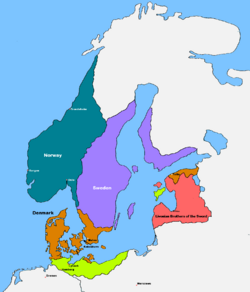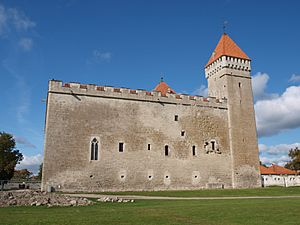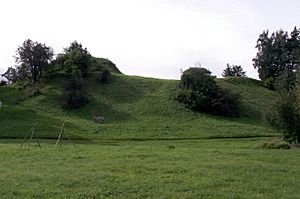Northern Crusades facts for kids
The Northern Crusades were a series of wars that took place in Northern Europe. They are also called the Baltic Crusades. During these crusades, Christian kingdoms and groups, mainly from Western Europe, tried to spread their religion (Christianity) and take control of new lands. They fought against people who had different beliefs (called pagans) and sometimes against other Christians in the areas around the Baltic Sea.
The most famous of these wars were the Livonian and Prussian crusades. Some of these wars were officially called crusades back then. However, others, like most of the Swedish ones, were only called crusades much later by historians. Still, Pope Pope Alexander III did approve crusades against Estonians and other pagans in the region in 1171 or 1172.
Contents
Why Did the Northern Crusades Happen?
At the start of the Northern Crusades, Christian rulers in Northern Europe sent armies into lands that are now Estonia, Finland, Latvia, Lithuania, Poland, and Russia. The local people, who were either pagans or Eastern Orthodox Christians, were often forced to convert to Catholicism. They also suffered from military takeovers.
The powerful Teutonic Order, a group of German Christian knights, gained a lot from these crusades. German merchants also benefited as they expanded their trade routes across the Baltic region.
The official start of the Northern Crusades was in 1195. That's when Pope Pope Celestine III called for them. But Christian kingdoms like Scandinavia, Poland, and the Holy Roman Empire had already started trying to control their pagan neighbors even earlier.
The main groups who were attacked during these campaigns included:
- The Polabian Wends, Sorbs, and Obotrites (fought by Saxons, Danes, and Poles, starting in 1147).
- The Finns proper (fought by Swedes and Danes from the 1150s to 1293).
- Livonians, Latgallians, Selonians, and Estonians (fought by Germans and Danes from 1193 to 1227).
- Semigallians and Curonians (fought from 1219 to 1290).
- Old Prussians.
- Lithuanians and Samogitians (fought by Germans, but without success, from 1236 to 1410).
Before the crusades, there had been many fights between the local people and their neighbors to the north and south. These earlier battles were mostly about destroying castles and controlling sea trade routes for money. The crusades continued this pattern, but now they were supported by the Pope and carried out by knights and monks.

Norway Sweden 1330s–1350s Denmark Conquered by Denmark in 1219 Livonia before 1343
Key Campaigns of the Northern Crusades
The Wendish Crusade (Starting 1147)
The crusades began with the Wendish Crusade in 1147. This was against the Polabian Slavs, also known as "Wends", who lived in what is now northern and eastern Germany. This crusade happened at the same time as the Second Crusade to the Holy Land. It continued on and off until the 16th century.
Swedish Crusades (1150–1293)
The Swedish crusades were military campaigns by Sweden. They were fought against the Finns, Tavastians, and Karelians between 1150 and 1293.
Danish Crusades (1187–1202)
The Danes also launched at least three crusades to Finland. The first mention of these is from 1187. Another two known crusades happened in 1191 and 1202. The later one was led by Bishop Anders Sunesen.
Livonian Crusade (1198–1290)
By the 12th century, the people living in what is now Estonia, Latvia, and Lithuania were mostly pagan. They were located between two powerful Christian groups: the Orthodox Church to the east and the Catholic Church to the west. This difference in beliefs was one reason they hadn't been converted yet. For over 150 years before the German crusaders arrived, Estonia was attacked many times by Russian, Danish, and Swedish forces. Estonians also raided Denmark and Sweden.
Some Catholics tried to convert the Estonians peacefully. These missions started around 1045. However, these peaceful efforts didn't have much success.
Campaign Against the Livonians (1198–1212)
German merchants were using the old Viking trade routes. A monk named Meinhard arrived at the Daugava river in present-day Latvia in 1180. He became a bishop in 1186. Pope Celestine III called for a crusade against the Baltic pagans in 1195. This call was repeated by Pope Innocent III.
A crusading army, led by Bishop Berthold of Hanover, landed in Livonia (part of present-day Latvia) in 1198. The crusaders won their first battle, but Bishop Berthold was killed. The crusaders were forced back.
In 1199, Albert of Buxhoeveden was chosen to Christianize the Baltic lands. By the time Albert died 30 years later, much of Estonia and northern Latvia had been conquered and formally Christianized. Albert started by traveling around, asking people to join the crusade. The Pope also helped by saying that fighting the Baltic pagans was as important as fighting in the Holy Land.
Albert arrived at the Daugava river in 1200 with only 23 ships and 500 soldiers. But his efforts brought a steady stream of new fighters. The first crusaders usually came in spring and went home in autumn. To keep soldiers there all the time, the Livonian Brothers of the Sword were founded in 1202. Albert also founded a market at Riga in 1201, which brought people and wealth. At Albert's request, Pope Innocent III dedicated the Baltic lands to the Virgin Mary. This helped encourage more people to join the army. The name "Mary's Land" (or Terra Mariana) is still used for Livonia today.

In 1206, the crusaders took control of the Livonian stronghold in Turaida. This was an important trading route. To control the other side of the river, a stone castle was built in Sigulda before 1210. By 1211, the Livonian areas of Metsepole and Idumea had converted to Catholicism. The last battle against the Livonians was the siege of Satezele hillfort in 1212.
The Livonians had first seen the Germans as helpful allies. Their leader, Caupo of Turaida, was one of the first Livonians to be baptized. But as the Germans took more control, the Livonians rebelled. They were defeated. Caupo of Turaida remained an ally of the crusaders until he died in the Battle of St. Matthew's Day in 1217.
The German crusaders used newly baptized Livonian warriors in their fights against other groups. These included the Latgallians and Selonians (1208–1209), Estonians (1208–1227), and the Semigallians, Samogitians, and Curonians (1219–1290).
Campaign Against the Latgallians and Selonians (1208–1224)
After defeating the Livonians, the crusaders turned to the Latgallian areas to the east. In 1208, the Principality of Tālava formed a military alliance and later converted from Greek Orthodoxy to Roman Catholicism. This was the only peaceful takeover of a Baltic tribe during the Northern Crusades. The ruler of Tālava, Tālivaldis, became a loyal ally of the German crusaders.
The war against the Latgallian and Selonian lands began in 1208. The crusaders took over the Orthodox Principality of Koknese and the Selonian Sēlpils hillfort. In 1209, they attacked the Orthodox Principality of Jersika. The crusaders claimed Jersika was allied with Lithuanian pagans. After their defeat, the king of Jersika, Visvaldis, became a vassal (a ruler who owes loyalty to another) of the Bishop of Livonia. He received part of his land back.
The Selonian stronghold of Sēlpils was briefly the center of a Selonian diocese (a church district). Later, it came under the rule of the Livonian Order. By 1224, the Latgallian lands finally became German possessions.
Campaign Against the Estonians (1208–1224)
By 1208, the Germans were strong enough to start fighting the Estonians. At that time, Estonia was divided into several counties, each led by elders. These groups did not always work together well. From 1208 to 1227, armies from different sides fought across Livonian, Northern Latgallian, and Estonian lands. Livonians and Latgallians usually helped the Crusaders. Russian groups from Polotsk and Pskov sometimes helped different sides.
Hillforts, which were important centers in Estonia, were attacked and captured many times. A truce (a temporary stop to fighting) was made for three years (1213–1215). This truce generally helped the Germans, who became stronger politically. The Estonians, however, could not unite their loose alliances into a strong state. The Livonian leader Kaupo was killed in battle near Viljandi in 1217. This battle was a huge defeat for the Estonians. Their leader, Lembitu, was also killed. Since 1211, Lembitu had been known as an important Estonian elder and a key figure in the Estonian resistance.
The Christian kingdoms of Denmark and Sweden also wanted to conquer lands on the eastern shores of the Baltic Sea. The Swedes only made one failed attempt in western Estonia in 1220. But the Danish fleet, led by King Valdemar II of Denmark, landed at the Estonian town of Lindanisse (now Tallinn) in 1219. After the Battle of Lindanise, the Danes built a fortress. Estonians attacked it in 1220 and 1223, but it held out. Eventually, all of northern Estonia came under Danish control.
Wars Against Saaremaa (1206–1261)
The last Estonian area to resist the invaders was the island of Saaremaa (Ösel). Its war fleets had raided Denmark and Sweden during the fights against the German crusaders.
In 1206, a Danish army led by King Valdemar II tried to build a stronghold on Saaremaa but failed. In 1216, the Livonian Brothers of the Sword and Bishop Theodorich invaded Saaremaa by crossing the frozen sea. In return, the people of Saaremaa raided German-controlled areas in Latvia the next spring. In 1220, the Swedish army conquered Lihula in Western Estonia. The people of Saaremaa attacked the Swedish stronghold that same year, captured it, and killed everyone inside.
In 1222, the Danish king Valdemar II tried to conquer Saaremaa again. This time, he built a stone fortress with a strong group of soldiers. But the Danish stronghold was attacked and surrendered within five days. The Danish soldiers returned to Tallinn, leaving some hostages for peace. The people of Saaremaa then destroyed the castle.
In January 1227, a large army of 20,000 soldiers, led by Papal legate William of Modena, crossed the frozen sea while the Saaremaa fleet was stuck in the ice. After two major strongholds on Saaremaa surrendered, the people of Saaremaa formally accepted Christianity.
In 1236, after the Livonian Brothers of the Sword were defeated in the Battle of Saule, fighting on Saaremaa started again. In 1261, the war continued as the people of Saaremaa had rejected Christianity again and killed all the Germans on the island. A peace treaty was signed after the combined forces of the Livonian Order, the Bishopric of Ösel-Wiek, and Danish Estonia defeated the people of Saaremaa. Soon after, the Livonian Order built a stone fort at Pöide.
Wars Against the Curonians and Semigallians (1201–1290)
The Curonians had attacked Riga in 1201 and 1210. But Albert of Buxhoeveden was hesitant to launch a big campaign against them. After Albert died in 1229, the crusaders peacefully gained control of Vanemane (an area in Courland) through a treaty in 1230.
After their big defeat in the Battle of Saule by the Samogitians and Semigallians, the remaining Swordbrothers were reorganized in 1237. They became part of the Teutonic Order and were known as the Livonian Order. In 1242, the crusaders began to conquer Courland. They defeated the Curonians and built their main fortress at Kuldīga.
At the Battle of Durbe in 1260, a force of Samogitians and Curonians defeated the combined armies of the Livonian and Teutonic Orders. However, over the next few years, the Crusaders slowly took control of the Curonians. In 1267, they signed a peace treaty. The southern parts of their lands that were not conquered joined the Grand Duchy of Lithuania.
The conquest of Semigallian areas began in 1219. Crusaders from Riga took over Mežotne, an important port. After several failed campaigns against the pagan Semigallian duke Viestards, the Church decided in 1251 to get rid of the Bishopric of Semigallia. Its lands were divided between the Bishopric of Riga and the Livonian Order. In 1265, a stone castle was built at Jelgava. This became the main military base for crusader attacks against the Semigallians.
In 1271, the main hillfort of Tērvete was captured. But the Semigallians, led by Duke Nameisis, rebelled in 1279. The Lithuanians defeated the Livonian Order in the Battle of Aizkraukle. Duke Nameisis's warriors attacked Riga in 1280 but failed. In response, about 14,000 crusaders attacked Turaida castle in 1281. To conquer the remaining Semigallian hillforts, the Order's master built a new castle next to Tērvete castle in 1287. That same year, the Semigallians tried to conquer Riga again but failed. On their way home, Livonian knights attacked them but were defeated in the Battle of Garoza. The new master of the Order organized the last campaigns against the Semigallians in 1289 and 1290. Most of the Semigallian warriors then joined the Samogitian and Lithuanian forces.
Prussian and Lithuanian Crusades
Early Campaigns Against Prussia (1147–1222)
From 1147, the Polish Duke of Mazovia, Boleslaw the Curly, led many expeditions against pagan Prussia. Some of these were successful, and parts of the Prussian lands were conquered.
Konrad I, another Polish Duke, tried to conquer pagan Prussia in crusades in 1219 and 1222 but failed. He created the crusading Order of Dobrzyń in 1220. However, this group was not very effective. Konrad's campaigns against the Old Prussians led to attacks back into his own lands. Konrad wanted to make his northern border more stable. Because he was militarily weak, Konrad asked the Teutonic Knights to come to Prussia in 1226 to defeat the Old Prussians.
Teutonic Order's Role (1226–1410)
The Northern Crusades helped the Teutonic Order grow and expand. This group of German crusading knights was founded in Palestine in the late 1100s. Duke Konrad I of Masovia asked the Knights to defend his borders and conquer the pagan Old Prussians in 1226. In 1234, a big expedition began. Polish forces and the Teutonic Knights defeated the Baltic Prussians. After conquering the Prussians, the Teutonic Knights fought against the Grand Duchy of Lithuania.
In 1236, the Livonian knights were crushed by the Samogitians and Semigallians in the Battle of Saule. At the same time, there were revolts in Estonia. The Livonian Order then became part of the Teutonic Order. This gave the Teutonic Knights control over large areas in the Baltic region.
Mindaugas, the King of Lithuania, was baptized with his wife after his coronation in 1253. He hoped this would stop the Crusaders' attacks, but it didn't. The Teutonic Knights failed to conquer Lithuania. Lithuania officially converted to Christianity in 1386. This happened when Grand Duke Jogaila married the young Queen Jadwiga of Poland. However, even after Lithuania became Christian, the conflict continued. It ended in 1410 at the Battle of Grunwald, also known as the First Battle of Tannenberg. In this battle, the Lithuanians and Poles, helped by Tatars, Moldovans, and Czechs, defeated the Teutonic Knights.
In 1221, Pope Pope Honorius III was worried about the situation in the Finnish-Novgorodian Wars. He allowed the Bishop of Finland to stop trade with the "barbarians" who threatened Christianity in Finland. Eight years later, this trade ban was specifically against the Russians. A few years later, the Pope also asked the Livonian Brothers of the Sword to send troops to protect Finland. It's not known if any knights ever arrived.
The Teutonic Order also tried to conquer Orthodox Russia (especially the Republics of Pskov and Novgorod). This effort was supported by Pope Pope Gregory IX. A major defeat for the idea of conquering Russia was the Battle of the Ice in 1242. Sweden also launched several crusades against Orthodox Novgorod.
Wars Against the Rus'
Livonian missionary and crusade activities in Estonia caused conflicts with Novgorod. Novgorod had also tried to control and convert the pagan Estonians. Sometimes, the Estonians even tried to ally with the Russians against the Crusaders.
Wars between the two sides continued off and on. These wars stopped the Teutonic Order from expanding further east. But Novgorod's attempts to take Estonia and Livonia also failed. The area remained firmly controlled by the Teutonic Order.
- Swedish–Novgorodian Wars
- Livonian campaign against Rus'
- Battle of Wesenberg
See also
 In Spanish: Cruzadas bálticas para niños
In Spanish: Cruzadas bálticas para niños
- Ostsiedlung
- Finnish–Novgorodian wars
- Christianization of Lithuania



